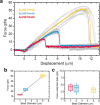Artificial Cell Membranes Interfaced with Optical Tweezers: A Versatile Microfluidics Platform for Nanomanipulation and Mechanical Characterization
- PMID: 31448892
- PMCID: PMC6753654
- DOI: 10.1021/acsami.9b09983
Artificial Cell Membranes Interfaced with Optical Tweezers: A Versatile Microfluidics Platform for Nanomanipulation and Mechanical Characterization
Abstract
Cell lipid membranes are the site of vital biological processes, such as motility, trafficking, and sensing, many of which involve mechanical forces. Elucidating the interplay between such bioprocesses and mechanical forces requires the use of tools that apply and measure piconewton-level forces, e.g., optical tweezers. Here, we introduce the combination of optical tweezers with free-standing lipid bilayers, which are fully accessible on both sides of the membrane. In the vicinity of the lipid bilayer, optical trapping would normally be impossible due to optical distortions caused by pockets of the solvent trapped within the membrane. We solve this by drastically reducing the size of these pockets via tuning of the solvent and flow cell material. In the resulting flow cells, lipid nanotubes are straightforwardly pushed or pulled and reach lengths above half a millimeter. Moreover, the controlled pushing of a lipid nanotube with an optically trapped bead provides an accurate and direct measurement of important mechanical properties. In particular, we measure the membrane tension of a free-standing membrane composed of a mixture of dioleoylphosphatidylcholine (DOPC) and dipalmitoylphosphatidylcholine (DPPC) to be 4.6 × 10-6 N/m. We demonstrate the potential of the platform for biophysical studies by inserting the cell-penetrating trans-activator of transcription (TAT) peptide in the lipid membrane. The interactions between the TAT peptide and the membrane are found to decrease the value of the membrane tension to 2.1 × 10-6 N/m. This method is also fully compatible with electrophysiological measurements and presents new possibilities for the study of membrane mechanics and the creation of artificial lipid tube networks of great importance in intra- and intercellular communication.
Keywords: cell membrane; lipid bilayer; lipid nanotube; microdevice; surface tension.
Conflict of interest statement
The authors declare no competing financial interest.
Figures






References
-
- Thottacherry J. J.; Kosmalska A. J.; Kumar A.; Vishen A. S.; Elosegui-Artola A.; Pradhan S.; Sharma S.; Singh P. P.; Guadamillas M. C.; Chaudhary N.; Vishwakarma R.; Trepat X.; del Pozo M. A.; Parton R. G.; Rao M.; Pullarkat P.; Roca-Cusachs P.; Mayor S. Mechanochemical Feedback Control of Dynamin Independent Endocytosis Modulates Membrane Tension in Adherent Cells. Nat. Commun. 2018, 9, 421710.1038/s41467-018-06738-5. - DOI - PMC - PubMed
MeSH terms
Substances
LinkOut - more resources
Full Text Sources

